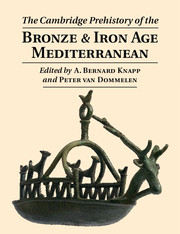Crossref Citations
This Book has been
cited by the following publications. This list is generated based on data provided by Crossref.
Düring, Bleda S.
2015.
Barbara Horejs and Mathias Mehofer, eds. Western Anatolia before Troy: Proto-Urbanisation in the 4th Millennium BC? Proceedings of the International Symposium held at the Kunsthistorisches Museum Wien, Vienna, Austria, 21–24 November, 2012 (Oriental and European Archaeology 1. Vienna: Austrian Academy of Sciences Press, 2014, 492pp., 218 b/w and colour illustr., 17 tables, ISBN 978-3-7001-7761-6).
European Journal of Archaeology,
Vol. 18,
Issue. 4,
p.
727.
Witcher, Robert
2015.
New Book Chronicle.
Antiquity,
Vol. 89,
Issue. 346,
p.
1010.
Bürge, Teresa
2021.
Mortuary Landscapes Revisited: Dynamics of Insularity and Connectivity in Mortuary Ritual, Feasting, and Commemoration in Late Bronze Age Cyprus.
Religions,
Vol. 12,
Issue. 10,
p.
877.
Portillo, Marta
Dudgeon, Kate
Anglada, Montserrat
Ramis, Damià
Llergo, Yolanda
and
Ferrer, Antoni
2021.
Phytolith and Calcitic Spherulite Indicators from Modern Reference Animal Dung from Mediterranean Island Ecosystems: Menorca, Balearic Islands.
Applied Sciences,
Vol. 11,
Issue. 16,
p.
7202.
Posth, Cosimo
Zaro, Valentina
Spyrou, Maria A.
Vai, Stefania
Gnecchi-Ruscone, Guido A.
Modi, Alessandra
Peltzer, Alexander
Mötsch, Angela
Nägele, Kathrin
Vågene, Åshild J.
Nelson, Elizabeth A.
Radzevičiūtė, Rita
Freund, Cäcilia
Bondioli, Lorenzo M.
Cappuccini, Luca
Frenzel, Hannah
Pacciani, Elsa
Boschin, Francesco
Capecchi, Giulia
Martini, Ivan
Moroni, Adriana
Ricci, Stefano
Sperduti, Alessandra
Turchetti, Maria Angela
Riga, Alessandro
Zavattaro, Monica
Zifferero, Andrea
Heyne, Henrike O.
Fernández-Domínguez, Eva
Kroonen, Guus J.
McCormick, Michael
Haak, Wolfgang
Lari, Martina
Barbujani, Guido
Bondioli, Luca
Bos, Kirsten I.
Caramelli, David
and
Krause, Johannes
2021.
The origin and legacy of the Etruscans through a 2000-year archeogenomic time transect.
Science Advances,
Vol. 7,
Issue. 39,
Betts, Eleanor
2021.
Greg Woolf. The Life and Death of Ancient Cities: A Natural History (Oxford: Oxford University Press, 2020, 528pp., 44 illustr., hbk, ISBN 9780199664733).
European Journal of Archaeology,
Vol. 24,
Issue. 4,
p.
559.
Pérez-Jordà, Guillem
Alonso, Natàlia
Rovira, Núria
Figueiral, Isabel
López-Reyes, Daniel
Marinval, Philippe
Montes, Eva
Peña-Chocarro, Leonor
Pinaud-Querrac’h, Rachël
Ros, Jérôme
Tarongi, Miguel
Tillier, Margaux
and
Bouby, Laurent
2021.
The Emergence of Arboriculture in the 1st Millennium BC along the Mediterranean’s “Far West”.
Agronomy,
Vol. 11,
Issue. 5,
p.
902.
Lucarini, Giulio
Bokbot, Youssef
and
Broodbank, Cyprian
2021.
New Light on the Silent Millennia: Mediterranean Africa, ca. 4000–900 BC.
African Archaeological Review,
Vol. 38,
Issue. 1,
p.
147.
Vionis, Athanasios K.
2022.
The Construction of Sacred Landscapes and Maritime Identities in the Post-Medieval Cyclades Islands: The Case of Paros.
Religions,
Vol. 13,
Issue. 2,
p.
164.
Papantoniou, Giorgos
and
Depalmas, Anna
2022.
Cyprus and Sardinia at the Transition from the Bronze to the Iron Age: A Sacred Landscape Approach.
Religions,
Vol. 13,
Issue. 1,
p.
48.
Papantoniou, Giorgos
Vionis, Athanasios K.
and
Morris, Christine E.
2022.
Religious and Insular Identities in Context: An Introduction.
Religions,
Vol. 13,
Issue. 10,
p.
903.
Valenzuela, Alejandro
Torres-Roig, Enric
Zoboli, Daniel
Pillola, Gian Luigi
and
Alcover, Josep Antoni
2022.
Asynchronous ecological upheavals on the Western Mediterranean islands: New insights on the extinction of their autochthonous small mammals.
The Holocene,
Vol. 32,
Issue. 3,
p.
137.
Greenfield, Haskel J.
Ross, Jon
Greenfield, Tina L.
Albaz, Shira
Richardson, Sarah J.
and
Maeir, Aren M.
2022.
Household Rituals and Merchant Caravanners: The Phenomenon of Early Bronze Age Donkey Burials from Tell eṣ-Ṣâfi/Gath, Israel.
Animals,
Vol. 12,
Issue. 15,
p.
1931.
Ong, Brenda Man Qing
and
Perono Cacciafoco, Francesco
2022.
Unveiling the Enigmatic Origins of Sardinian Toponyms.
Languages,
Vol. 7,
Issue. 2,
p.
131.
Gebbia, Vittorio
Piazza, Dario
Valerio, Maria Rosaria
Di Paola, Jessica Joy
and
Cusumano, Nicola
2023.
Breast Cancer in Two Ex-Votos, A Millennia Apart: Patients' Hope and Faith Expressed Through the Centuries in Votive Offerings.
Journal of Religion and Health,
Vol. 62,
Issue. 3,
p.
1976.
Almeida, Nelson J.
Serra, Miguel
Porfírio, Eduardo
and
Silva, Sofia
2023.
Animal exploitation in Southwestern Iberia at the end of the second millennium BCE: insights from the Late Bronze Age of Outeiro do Circo (Beja, Portugal).
Complutum,
Vol. 34,
Issue. 1,
p.
57.



